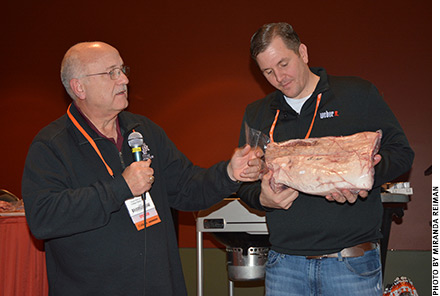The Science of Grilling
Meat experts share tips to perfect the grilling experience.
SAN ANTONIO, Texas (Feb. 4, 2015) — A good grill, good meat, good seasoning and good instructions — they all add up to great barbecue, said Kevin Kolman, grill master for the Weber® brand.
He and Jeff Savell, Texas A&M University meat scientist, jointly offered tips during “The Science of Grilling” presentation Feb. 4. The session at the 22nd Cattlemen’s College® was part of the 2015 Cattle Industry Convention & NCBA Trade Show in San Antonio, Texas.
 He and Jeff Savell, Texas A&M University meat scientist, jointly offered tips during “The Science of Grilling” presentation Feb. 4.
He and Jeff Savell, Texas A&M University meat scientist, jointly offered tips during “The Science of Grilling” presentation Feb. 4. “You’ve got to have a great product to start with,” Kolman said, noting he trusts proven quality, like the Certified Angus Beef® (CAB®) brand and Prime.
“Let the beef shine and complement it with seasoning and smoke,” Savell said. “Don’t overpower it.” It’s often as simple as salt and pepper and smoking with a familiar wood, such as oak.
Regardless of whether you’re using gas or charcoal, preheating for 10-15 minutes is an important step.
Determine heat method: direct for thinner pieces of meat but indirect, roasting or smoking for those thicker products.
Don’t forget an important piece of equipment: “Logic is our friend — use a meat thermometer,” Savell said.
The team spent time walking the audience through a Texas staple.
“I want consistency. I want to go to the same source each time for the brisket,” Kolman said. “You’re trying to mitigate as many liabilities in that process as you can. If I’ve got the pit, I know how to set that up. If I know how to season it, I’ve got that portion taken care of. … You almost have to go through the whole process and mitigate as many liabilities as you can. Having the same brisket is huge.”
Oftentimes professional smokers will wrap their brisket during cooking.
“I’m a wrapper,” Kolman says, noting that’s at 150°-160° F. “Part of the reason I wrap or put it in a foil pan is that I want to save that liquid gold we call fat.” He reserves the drippings to add flavor to side dishes.
Be sure to let beef “rest” before cutting into it after it leaves the heat sources, Kolman said, suggesting 30%-40% of the amount of time it was on the grill.
“It allows the meat to relax and allows some of the moisture to go back,” he said. “It’s more tender and more flavorful.”
Born a “city kid,” Kolman talked about his experience seeing the beef industry from start to finish. Visiting producers and a packing plant highlighted his career’s purpose.
“What I took away from it is the amount of time ranchers are putting in on raising cattle,” he said. “My job as an educator and a product guy is to make a better grill and provide better instructions, so it highlights what you’re doing on the front end. Now your products are that much better because they’re grilled better.”.
Editor’s Note: The articles used within this site represent a mixture of copyrights. This article was written by staff or under contract for the Angus Journal. If you would like to reprint or repost an article, you must first request permission of the Angus Journal by contacting the editor at 816-383-5200; 3201 Frederick Ave., Saint Joseph, MO 64506. The Angus Journal claims copyright to this website as presented. We welcome educational venues and cattlemen to link to this site as a service to their audience.

